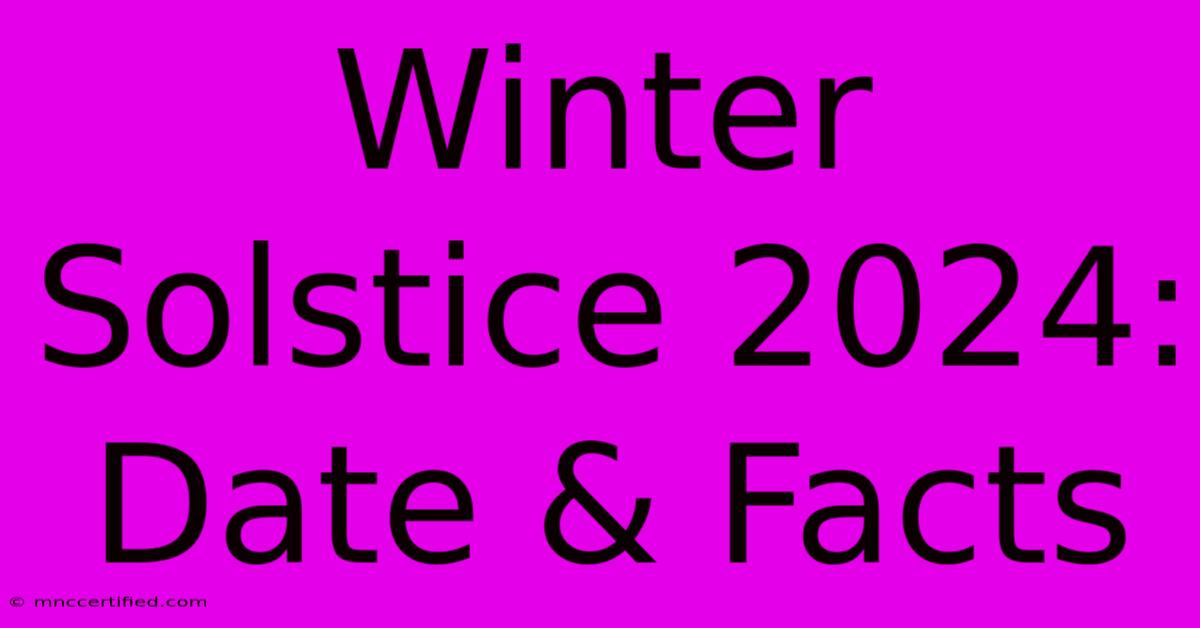Winter Solstice 2024: Date & Facts

Table of Contents
Winter Solstice 2024: Date & Fascinating Facts
The Winter Solstice, a celestial event marking the shortest day and longest night of the year in the Northern Hemisphere, holds a significant place in cultures worldwide. This year, it falls on December 21st, 2024, a date eagerly anticipated by many. But what exactly is the Winter Solstice, and what makes it so special? Let's delve into the fascinating facts surrounding this astronomical phenomenon.
Understanding the Winter Solstice
The Winter Solstice occurs when the Earth's tilt is furthest away from the sun, resulting in the least amount of direct sunlight in the Northern Hemisphere. This is the point at which the sun appears to reach its lowest point in the sky at noon. It's the official start of winter, astronomically speaking, though meteorologically, winter begins on December 1st.
The term "solstice" itself comes from the Latin words "sol" (sun) and "sistere" (to stand still). This refers to the apparent pause in the sun's movement before it begins its northward journey again. This seemingly stationary position is only an effect of the Earth's axial tilt and orbit.
Key Differences Between the Winter Solstice and the Summer Solstice
It's important to distinguish the Winter Solstice from the Summer Solstice. While the Winter Solstice marks the shortest day and longest night, the Summer Solstice marks the longest day and shortest night. They occur approximately six months apart, representing the two extremes of daylight hours throughout the year.
Cultural Significance of the Winter Solstice
For millennia, the Winter Solstice has held profound cultural and spiritual significance across various civilizations. Many ancient cultures celebrated this day with festivals, rituals, and traditions designed to honor the sun and celebrate the promise of its return and the eventual lengthening of days.
Ancient Traditions and Modern Celebrations
- Stonehenge: This iconic prehistoric monument in England is believed to have been aligned with the Winter Solstice sunrise, suggesting its importance to Neolithic people.
- Yule: In many Northern European cultures, the Winter Solstice is celebrated as Yule, a pagan festival with roots stretching back centuries. It often involves bonfires, feasting, and evergreen decorations, symbolizing the enduring strength of nature and the hope for spring’s return.
- Christmas: While not directly tied to the Solstice, the date of Christmas has been suggested to be influenced by earlier Winter Solstice celebrations, reflecting a blend of pagan and Christian traditions.
- Modern Celebrations: Today, many people mark the Winter Solstice with reflective practices, spending time in nature, participating in solstice-themed events, or simply enjoying the quiet stillness of the longest night.
Scientific Explanations: Why Does the Solstice Occur?
The Winter Solstice is a direct result of the Earth's axial tilt of approximately 23.5 degrees. This tilt means that different parts of the Earth receive varying amounts of direct sunlight throughout the year. During the Winter Solstice, the Northern Hemisphere is tilted furthest away from the sun, leading to the shortest day and longest night.
The Earth's Orbit and its Influence
The Earth's orbit around the sun is also a crucial factor. The combination of the Earth's tilt and its elliptical orbit determines the precise timing and duration of the solstice. It's a complex interplay of celestial mechanics that creates this annual event.
Beyond the Date: Observing the Winter Solstice
While December 21st, 2024, marks the official date, the solstice itself is a moment in time. Consider taking some time to appreciate the significance of this event. Observe the sunrise and sunset, reflect on the cyclical nature of the year, and perhaps participate in a local solstice celebration.
Conclusion: Embracing the Magic of the Winter Solstice
The Winter Solstice 2024 offers a unique opportunity to connect with nature, history, and the celestial wonders of our universe. Understanding its scientific basis and appreciating its rich cultural heritage allows for a deeper understanding and appreciation of this significant astronomical event. So, mark your calendars for December 21st, 2024, and embrace the magic of the shortest day and longest night.

Thank you for visiting our website wich cover about Winter Solstice 2024: Date & Facts. We hope the information provided has been useful to you. Feel free to contact us if you have any questions or need further assistance. See you next time and dont miss to bookmark.
Featured Posts
-
Watch Bayern Vs Leipzig Free Stream
Dec 21, 2024
-
Zoe Balls Tearful Radio 2 Goodbye
Dec 21, 2024
-
December Solstice 2024 Daylight Hours
Dec 21, 2024
-
Bitcoin Falls To 96000 Amid Market Volatility
Dec 21, 2024
-
Fed Hawks Hit Xrp Eth Sol
Dec 21, 2024